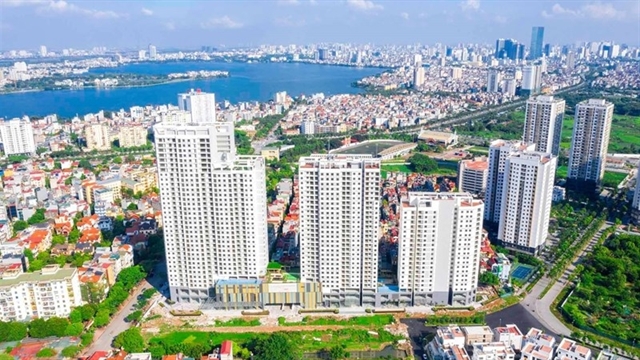[ad_1]

Hà Nội — The Hà Nội real estate market in the first quarter of 2022 saw signs of improvement in the segments of retail, office and villas/townhouses, while the apartment segment had a more bleak performance, according to Savills Vietnam.
The Savill Vietnam’s real estate market report in Hà Nội in the first quarter of 2022, released this week, noted that the supply in Hà Nội’s retail market increased by 1 per cent in the quarter. This figure reflected the slow growth of retail property over the past three years. The new supply was limited.
Ground floor rents increased by 5 per cent over the quarter and 4 per cent over the year with stable occupancy. Rents rose the fastest in the central business districts and eastern Hà Nội, with an average growth of 5 per cent per annum since 2018.
Economic recovery was evident, with Hà Nội’s GRDP increasing by 5.8 per cent on the year and retail sales rising by 9.1 per cent. Besides, the business expansion plans of some retailers would make the retail space market develop more, according to the report.
“Luxury retail brands are seeking sites in Hoàn Kiếm District, which is pushing up ground floor rent in the area. However, mid-end retail brands are still cautious about expansion after COVID-19. The growth of e-commerce is undoubtedly impacting traffic in shopping malls,” said Hoàng Nguyệt Minh, director, Commercial Leasing, Savills Hà Nội.
For the office market, the supply in Hà Nội witnessed a slight growth in the first quarter, led by Grade B projects with 50 per cent of supply. The secondary area led with 870,000sq.m or 40 per cent, followed by the West, especially Cầu Giấy District.
Companies in ICT and finance, banking and insurance led deals in the secondary area and real estate businesses dominated in the West.
Leasing will be strong in 2022. Offices in green buildings will have a competitive advantage as tenants seek quality offices in prime locations that are not simply spaces for desks, but workspaces that act as a tool to protect the environment, boost productivity, and attract and retain talent.
“Tenants will have choices of new high-quality Grade A properties entering the end of the year, mostly in central business districts (CBD) and mid-town. New properties will complete with the existing building regarding quality, services and pricing,” said Minh.
Savill Vietnam also reported the new supply in the villas/townhouse market reached 801 dwellings in the first quarter, up 227 per cent on quarter but down 15 per cent on-year, coming from two new projects and the next phases of three existing projects.
The primary stock of 1,513 dwellings increased 35 per cent on quarter but decreased 24 per cent over the year, which was distributed throughout the city.
Performance in this segment improved with 666 sales, increasing 62 per cent on quarter but decreasing 29 per cent on the year. Townhouse and shophouse were the two products with the strongest consumption in the market.
The average primary villa price of VNĐ134 million per sq.m, a decrease of 26 per cent on quarter but an increase of 30 per cent over the year. The townhouse average of VNĐ185 million per sq.m surged 8 per cent on the quarter and 73 per cent on the year, while the shophouse price of VNĐ323 million per sq.m was up 35 per cent on the quarter and 79 per cent on the year.
Until the end of the year, more than 1,600 dwellings from 10 projects will enter, mainly from Hoài Đức and Hà Đông distrcits. As supply in Hà Nội is limited, investors will look for properties in expanding surrounding markets such as Bắc Ninh, Bắc Giang, Hưng Yên or Hòa Bình.
In the villa/townhouse market: “The prospect of price increases and inflationary pressure, against restricted lending may slow performance in the short term,” said Matthew Powell, Director, Savills Hanoi.
Meanwhile, the market of apartments for sale had no new projects, and all new supply came from the next phases of six existing projects, the report noted.
The number of transactions decreased while the selling price increased in the first quarter. However, the Hà Nội apartment market remained in high demand, according to the report. The urbanisation rate, the natural population growth rate, and the middle class’s rise will be the main drivers to boost the demand for apartments in the future.
“Following a soft quarter, Hà Nội’s apartment market is expected to bounce back quickly. Decentralised infrastructure improvement will support real estate development,” said Đỗ Thu Hằng, senior director, advisory Services, Savills Hà Nội.
Prices have trended upwards since the first quarter of 2019. Over the last five years, Grade B average primary prices increased the most at 8 per cent per annum, followed by Grade C and Grade A with a growth of 7 per cent and 4 per cent, respectively.
With large land banks, the five upcoming suburban districts of Hoài Đức, Đông Anh, Thanh Trì, Gia Lâm and Đan Phượng will become key residential development targets, accounting for 24 per cent of future supply. — VNS
[ad_2]
Source link
